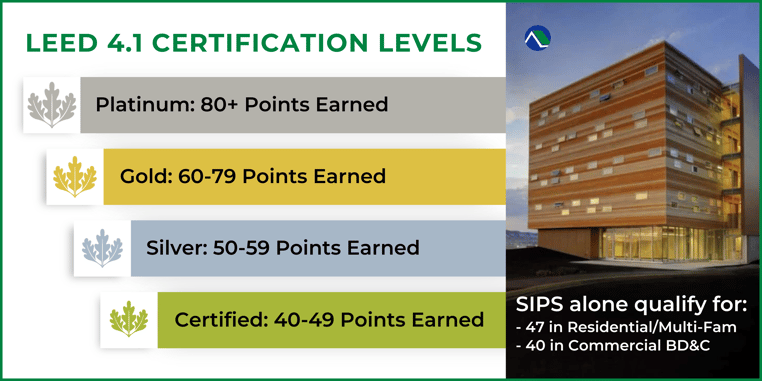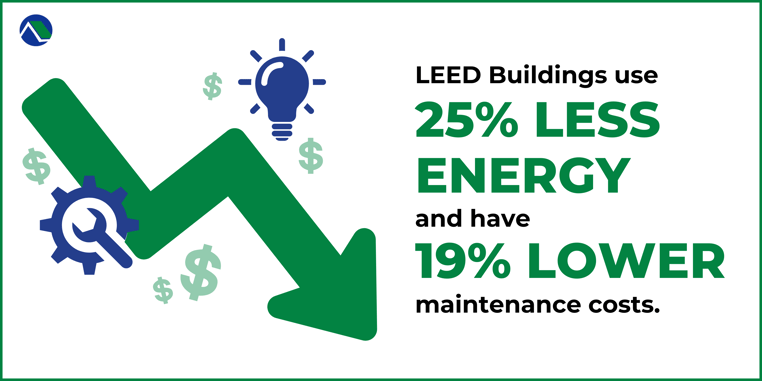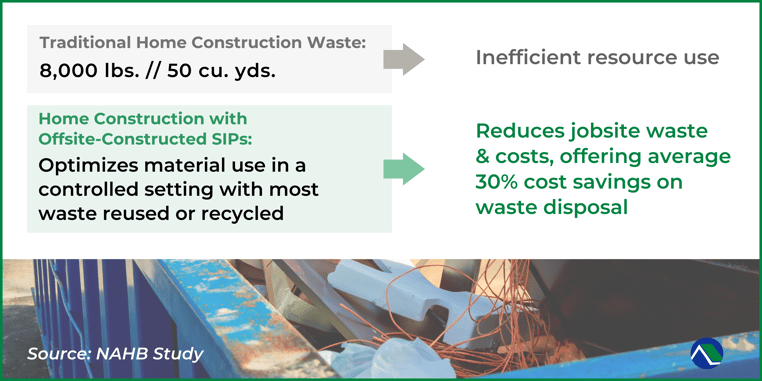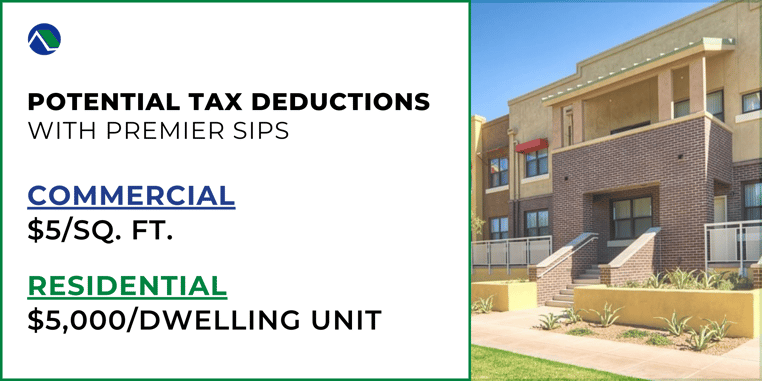In an era of increased environmental consciousness, sustainable building practices have become a cornerstone of the construction industry.
For those who take pride in being innovators with practices that are smarter for the planet, LEED (Leadership in Energy and Environmental Design) stands out as a globally recognized standard for evaluating and certifying the sustainability of buildings. With the introduction of LEED 4.1 certification, commercial, residential, and multi-family construction projects have new opportunities to enhance their environmental performance.
In this blog, we'll explore the value of LEED certification in commercial, residential, and multi-family construction, with a specific focus on how Premier SIPS' structural insulated panels play a leading role in achieving high LEED ratings.
LEED Certification: A Glimpse at Its Significance
LEED certification has long been synonymous with sustainable building practices. The current LEED 4.1 represents an updated and refined version of the original LEED certification standards, aiming to make it even more accessible and beneficial for construction projects.
LEED 4.1 addresses various aspects of sustainability, including energy efficiency, water conservation, indoor air quality, and resource management. Its rigorous criteria are designed to promote eco-friendly and energy-efficient building practices.
Value in Commercial Construction
For commercial construction, achieving LEED 4.1 Building Design & Construction (BD+C) certification brings several compelling advantages:
- Environmental Responsibility: LEED-certified commercial buildings are recognized as environmentally responsible structures. This reputation can attract environmentally conscious tenants and customers, enhancing the building's marketability.
- Operational Savings: LEED-certified buildings typically consume less energy and water, resulting in reduced utility bills and lower ongoing costs. These operational savings contribute to the long-term financial health of the building. On average, LEED buildings use 25% less energy and have 19% lower maintenance costs than non-certified facilities.
- Government Incentives: Some local governments offer incentives, such as tax breaks or expedited permitting, for LEED-certified commercial projects. This can further offset construction costs. (More on this below — read on!)
- Tenant Satisfaction & Reduced Turnover: Improved indoor air quality and comfort in LEED-certified buildings contribute to higher tenant satisfaction and lower tenant turnover. LEED certification also increases occupant satisfaction and reduces tenant churn. Specifically, LEED buildings report 27% higher occupant satisfaction and 6% higher occupancy rates. LEED certification provides companies with a competitive advantage in the labor market, with 79% of employees preferring jobs in LEED-certified buildings over uncertified ones, as per a U.S. Green Building Council survey. Additionally, companies that implemented LEED retrofits reported higher productivity (87%), improved employee retention rates (81%), and enhanced employee health (75%).
- Higher Rents: LEED properties command rent premiums of at least 2.1% compared to non-certified buildings. This rent premium can grow to over 13% as the building age increases. Similarly, LEED properties generate 60% more rent per square meter and sell for 60% more per square meter than equivalent non-certified buildings. By not getting LEED certified, building owners are missing out on substantial rental revenue each month.
- Valuable Tax Incentives: The requirements for LEED certification complement what is required for receiving incredibly lucrative Tax Deductions for Commercial construction — up to $5 per square foot back to the owner and/or building designers as of January 2023. (Keep reading for more details on this.)
- Lower Insurance: LEED-certified commercial buildings offer an often-overlooked advantage of lower insurance rates. This is because insurers perceive the focus on energy efficiency in these buildings as a sign of high operational standards, reducing the risk of insurance claims. Some insurers even provide discounts of 5% or more for LEED buildings, translating to approximately $0.02 per square foot in savings annually. For instance, a 100,000-square-foot building could save $2,000 per year on insurance. These reduced premiums can offset a significant portion of the LEED certification fees, covering 66% for existing buildings ($0.03 per square foot) or 45% for new constructions ($0.045 per square foot). In just five years, the insurance discounts alone can recover 3 to 4 times the certification fee, depending on the building's age.
- Exempt from mandatory energy audits: LEED-certified buildings are exempt from mandatory energy audits in certain municipalities and states (e.g., New York City, Austin, Columbus, New Jersey, California, and Washington). This exemption can save building owners additional costs, as filing fees for an audit in New York City range from $300 to $500, and the entry-level ASHRAE audit costs between $0.01 and $0.04 per square foot, with a minimum cost of $2,000 to $3,000.

Value in Residential Construction
LEED 4.1 certification is not limited to commercial projects; it is equally valuable in residential construction:
- Energy Efficiency: LEED 4.1 Residential & Multifamily encourages residential projects to incorporate energy-efficient features, which lead to lower utility bills and a smaller carbon footprint for homeowners.

- Health and Comfort: When it comes to LEED-certified homes, the well-being of residents is a top priority. These homes prioritize indoor air quality, creating a healthier and more comfortable living environment. In fact, LEED-certified homes often provide an elevated level of comfort, which adds to their overall appeal in the market. Buyers are increasingly willing to invest in homes that prioritize their health and well-being, making LEED certification a valuable selling point.
- Market Value: LEED-certified homes often have higher market values and can sell for a premium compared to non-certified homes. This is because buyers are increasingly prioritizing sustainable and energy-efficient features in their home purchases. With the rising awareness of climate change and the desire to reduce carbon footprints, LEED-certified homes offer a unique selling point. LEED-certified homes are seen as investments in a greener future, as they not only provide immediate benefits in terms of energy savings and reduced utility bills but also contribute to a more sustainable and resilient community. The market value of LEED-certified homes reflects the long-term value they bring to homeowners and the positive impact they have on the environment.
- Sustainable Living: LEED certification promotes sustainable living practices, which can positively impact the lifestyle and awareness of homeowners and residents. By incorporating green building techniques and materials, LEED-certified homes encourage residents to adopt more environmentally friendly habits. This includes using energy-efficient appliances, conserving water, recycling, and reducing overall waste. LEED-certified homes serve as a model for sustainable living, inspiring residents to make conscious choices that benefit both the environment and their own well-being. With LEED certification, homeowners can take pride in knowing they live in a home that aligns with their values and contributes to a more sustainable future.
- Multi-family ROI Benefits:
- Resident Happiness & Decreased Churn: The enhanced indoor air quality and comfort found in LEED-certified buildings result in greater resident contentment and reduced turnover rates. In fact, LEED buildings boast a 27% increase in occupant satisfaction and a 6% rise in occupancy rates.
- Increased Rental Value: LEED-certified residential units have the advantage of commanding higher rent prices, with premiums of at least 2.1% compared to non-certified residences. As buildings age, this rent premium can even grow to over 13%. Failing to adhere to LEED standards or retrofitting existing residences means missing out on significant potential investment revenue.

Premier SIPS: The LEED Advantage
One of the most effective ways to achieve high LEED ratings in both commercial and residential construction is with Premier SIPS framing systems. These structural insulated panels offer exceptional insulation, airtightness, and energy efficiency (60% to 100% savings for net-zero energy projects), all of which are highly valued in both LEED 4.1 certification programs.
Here's why Premier SIPS are a game-changer:
- Energy Efficiency: Premier SIPS provide superior thermal performance, reducing heating and cooling demands. This aligns perfectly with LEED’s focus on a requirement for energy conservation.
- Airtightness: Premier SIPS are known for their exceptional airtightness when properly installed, minimizing air infiltration and heat loss. How airtight a building is serves as the primary contributor to the amount of energy a building consumes or saves.
- Indoor Air Quality: Premier SIPS contribute to a healthier indoor environment, a key consideration in LEED certification. Premier SIPS in many applications are already certified Clean Air Gold.
- Resource Efficiency: The use of SIPs often results in less material waste compared to traditional framing, supporting LEED's resource conservation goals.

Premier SIPS' impressive sustainable features position them as an asset in achieving high LEED ratings for commercial, residential, and multi-family construction projects.
Their contribution to energy efficiency, resource conservation, and indoor comfort makes them an ideal choice for designers, builders, building owners, and homeowners to achieve certification and demonstrate their commitment to making an impact for the future with sustainable building practices.
LEED Certification “Leads” to Huge Project Tax Incentives
LEED projects can help substantiate or qualify for various tax incentives, although the availability and specifics of these incentives can vary depending on your location and the specific LEED certification level achieved. Here are some other ways in which LEED projects may qualify for tax incentives:
- Federal Tax Incentives: In the United States, the federal government offers tax incentives for energy-efficient and environmentally friendly construction through programs like the Energy Policy Act (EPAct) and the Investment Tax Credit (ITC). LEED-certified projects that meet certain energy efficiency requirements may be eligible for these incentives. Commercial project designers and/or owners can qualify for $5 per square foot in tax deductions for energy-efficient buildings (like those built with SIPS). Builders can qualify for $5,000 per dwelling unit for residential or multi-family structures.

- State and Local Incentives: Many U.S. states and local governments offer additional tax incentives, rebates, or deductions for green building and energy-efficient construction. These incentives can vary widely by location and can include property tax incentives, income tax credits, and sales tax exemptions. See the available incentives in your area.
- Renewable Energy Tax Credits: Some LEED projects may incorporate renewable energy systems like solar panels or wind turbines. These projects may be eligible for federal, state, or local tax credits specific to renewable energy generation.
- Green Building Certification Incentives: Some municipalities offer property tax incentives or fee reductions for projects that achieve LEED certification or other green building certifications. These incentives are designed to promote sustainable building practices.
- Historic Preservation Tax Credits: LEED projects involving the renovation or restoration of historic buildings may be eligible for historic preservation tax credits, which can offset a portion of the project costs.
- Low-Income Housing Tax Credits: LEED-certified affordable housing projects may qualify for low-income housing tax credits, which can be valuable for developers focused on providing sustainable and affordable housing. As of 2023, these may also be paired with federal residential/commercial energy efficiency incentives for multi-family projects.
It's important to note that the availability of these tax incentives and their specific requirements can change over time and may vary by region. Additionally, the level of LEED certification achieved (e.g., LEED Silver, Gold, or Platinum) and the specific green building features incorporated into the project can influence eligibility for tax incentives.
SIPS Deliver Sustainability
LEED certification offers a robust framework for assessing and improving the sustainability of construction projects. Whether in commercial or residential construction, achieving LEED certification brings numerous benefits, including environmental responsibility, cost savings, and increased market value.
Premier SIPS' exceptional energy efficiency and sustainable attributes make them a key component in achieving high LEED ratings, aligning perfectly with the values of modern, environmentally conscious builders and homeowners.
With Premier SIPS, sustainable building isn't just a goal, it's a reality.




